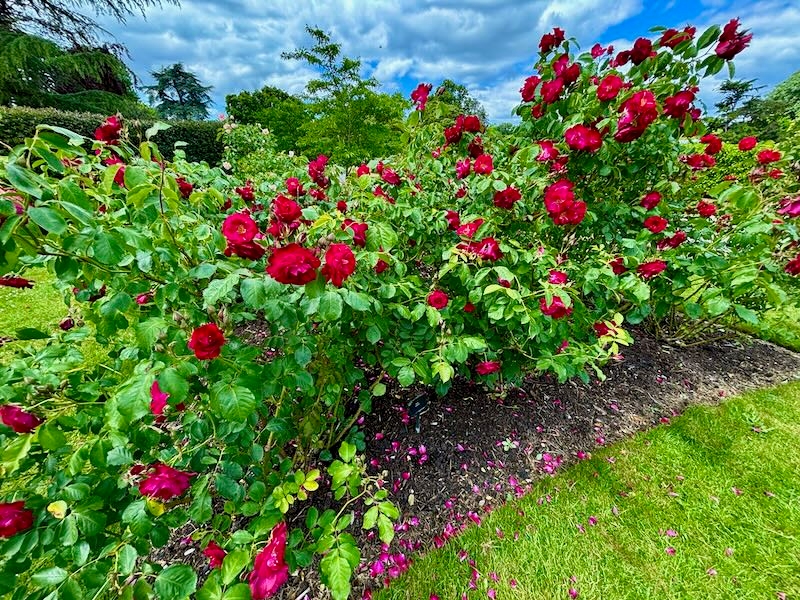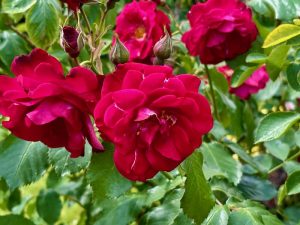Rosa ‘Wilhelm’ (Skyrocket): A Vigorous Hybrid Musk Rose for Garden Drama
Rosa ‘Wilhelm’, more widely known by its exhibition name ‘Skyrocket’, is a dark red Hybrid Musk rose introduced in 1934 by famed German breeder Wilhelm Kordes II. Belonging to the Rosaceae family, this vigorous rose combines old-world charm with garden-worthy resilience. With its dense foliage, fragrant flowers, and repeat blooming habit, ‘Wilhelm’ is an excellent choice for mixed borders, rose hedges, or even training as a climber.
Background and Breeding
Bred in Germany before World War II, ‘Wilhelm’ emerged from the Kordes family’s renowned rose-breeding program. Registered under the name ‘Skyrocket’, the rose blends the genetics of Hybrid Musk and Lambertiana lines. This rose represents a transitional moment in 20th-century rose breeding: compact enough for garden shrubs, yet vigorous and floriferous like climbers.
Plant Description
Habit and Foliage
Rosa ‘Wilhelm’ forms a bushy, upright shrub reaching between 6 to 8 feet (185 to 245 cm) in height, with a spread of up to 5 feet (150 cm). Its canes are thorny and support glossy, dark green foliage that stays healthy throughout the growing season. This dense leaf structure provides a strong architectural base for the vivid floral display.
Flowers
The rose bears small, double flowers (17-25 petals), each about 2.75 inches (7 cm) in diameter. These dark crimson blooms emerge in large clusters, aging gracefully into a purplish hue. At the heart of each flower lies a prominent cluster of golden-yellow stamens, creating striking contrast. While not overpowering, the blooms emit a moderate honey-musk fragrance.
‘Wilhelm’ flowers in flushes from early summer to late autumn. Its long, pointed buds are especially elegant, giving way to open, semi-double flowers that attract pollinators and the admiring eye alike. When left unpruned, the plant produces a notable crop of red hips in autumn, offering winter interest and food for birds.
Growing Conditions for Rosa ‘Wilhelm’
Light
‘Wilhelm’ thrives in full sun but can tolerate light shade. For best flowering, provide at least 6 hours of direct sunlight daily.
Soil
This rose prefers fertile, humus-rich, well-drained soil. Amend heavy clay soils with compost, grit, or other organic material to enhance drainage. It adapts to most soil types and pH ranges.
Watering
Keep the soil consistently moist, especially during dry spells. Water deeply at the base rather than overhead to prevent disease. In pots, check moisture levels more frequently.
Fertilization
Feed with a balanced rose fertilizer in early spring, just as new growth appears, and again in early summer after the first flush of blooms. Mulch with compost or well-rotted manure in late winter to improve soil texture and feed the roots.
Pruning Rosa ‘Wilhelm’
As a versatile shrub, ‘Wilhelm’ responds well to standard rose pruning practices.
- For shrubs: Follow pruning group 21 by removing dead, damaged, or congested stems and reducing height by about one-third in late winter.
- For climbers: Follow group 17 guidelines by tying long canes to horizontal supports and shortening lateral shoots to 2-3 buds.
- Deadheading: Remove spent flowers regularly to encourage further blooming unless you want rose hips.
Propagation
Propagate Rosa ‘Wilhelm’ using semi-hardwood cuttings in late summer or hardwood cuttings in autumn. The rose also responds well to T-budding in mid to late summer.
Propagation steps:
- Take 9 to 12-inch cuttings from healthy stems.
- Remove lower leaves and dip cut ends in rooting hormone.
- Plant in sandy compost or soil mix.
- Keep covered and humid until roots form.
Pests and Diseases
While ‘Wilhelm’ is generally healthy, it may occasionally suffer from common rose pests and diseases:
- Pests: Aphids, spider mites, leafhoppers, scale, sawflies, and caterpillars.
- Diseases: Powdery mildew, black spot, rust, dieback, and replant disease.
Good air circulation, proper pruning, and routine monitoring help minimize these issues.
Seasonal Interest and Wildlife Value
‘Wilhelm’ is a repeat bloomer from early summer to late autumn, providing consistent color. In fall, if not deadheaded, it develops a showy crop of red hips, extending garden interest into winter and attracting birds.
This rose’s moderate fragrance and open flower form make it appealing to pollinators. Its dense habit also offers habitat for garden insects and shelter for birds.
Landscape Uses of Rosa ‘Wilhelm’
Rosa ‘Wilhelm’ is suitable for:
- Mixed borders
- Informal hedges
- Climbing over trellises or obelisks
- Cottage and wildlife gardens
- Cut flower use
Whether planted as a freestanding shrub or trained along a fence, it brings long-lasting color, fragrance, and form to the garden.
Final Thoughts
With its old-fashioned charm, rich coloration, and dependable performance, Rosa ‘Wilhelm’ (or Skyrocket) is a vintage cultivar that remains relevant today. Its ability to bloom repeatedly, tolerate diverse conditions, and resist disease makes it a valuable addition to both traditional and modern gardens. For those who appreciate historical roses with robust performance, ‘Wilhelm’ stands tall—both literally and horticulturally.



